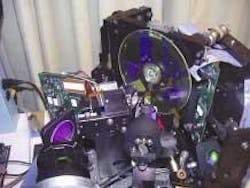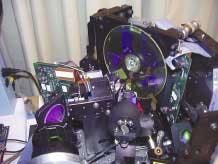Blu-ray meets blue sky
In February of last year, nine companies jointly established the basic specifications for a next-generation large-capacity optical disk video recording format, called Blu-ray disk, which enables the recording, rewriting, and playback of up to 27 gigabytes (Gbytes) of data on a single-sided, single-layer 12-cm CD/DVD disc using a 405-nm-emitting blue-violet laser. The nine companies are Hitachi (Tokyo, Japan), LG Electronics (Seoul, Korea), Matsushita Electric Industrial (Osaka, Japan), Pioneer (Tokyo, Japan), Royal Philips Electronics (Eindhoven, The Netherlands), Samsung Electronics (Seoul, Korea), Sharp (Midland, TX), Sony (Tokyo, Japan), and Thomson (Paris, France).
With all this heavyweight support, Blu-ray disk is generating plenty of excitement and getting a lot of developmental attention. But alternatives are being pursued. Concerns that have yet to be addressed with Blu-ray technology include the thinness of the media and the cost of the blue lasers, while projections of near-term storage needs are already growing beyond 25 Gbytes to 30 and even 50 Gbytes. Much work is already being done to address these issues, but much work is also going into developing alternative storage-boosting technology candidates to compete with Blu-ray for the near term, as well as several innovative blue-sky concepts that might eventually supersede Blu-ray (or the eventual near-term solution) in the long term. Many of these approaches were presented at the Optical Data Storage (ODS) 2003 topical meeting held in Vancouver in May (see figure).
"There is work going on to create materials, hard coats and so on, to make the media resistant enough so the they could be made without a cartridge," said Michael O'Neill, senior vice-president of Calimetrics (Alameda, CA) and general co-chair of ODS. The first Blu-ray systems, which provide about 25 Gbytes of optical storage in the size of a CD are also rewriteable. But extending the Blu-ray disk system to read-only memory (ROM) for manufacturing commercial CDs and DVDs, for example, requires preformatting of small pit patterns with an exposure spot size smaller than conventional mastering can provide.
Proposed techniques for dealing with this include electron-beam, deep-ultraviolet, and near-field mastering, which are also figuring into long-term plans for storage capacities on the order of 100 Gbyte. Sony engineers described an electron-beam mastering process for a 100-Gbyte capacity disk at this year's meeting that was achieved by optimization of the silicon etching process. Sony engineers also introduced a new approach to ROM on Blu-ray disk based on a phase-transition mastering method that uses an inorganic photoresist and a 405-nm-emitting laser diode. The focus of the latter approach is to produce a 25-Gbyte Blu-ray ROM without increasing marketing complexity and cost in relation to conventional CD and DVD mastering.
New media needed
While near-field mastering may provide a route to a Blu-ray ROM, the same near-field technology, when applied to data-storage systems, represents a fundamental shift in the technology that would require development of new media, O'Neill said. It would enable laser writing of much smaller spot sizes and could significantly boost storage capacity, even using currently available red laser technology, but it requires the head to fly very low over the surface of the media, which raises issues of lubrication, head crashing, media deformation, and the need for a protective cartridge. Numerous issues will need to be solved before near-field becomes viable in cost. At the Vancouver meeting, however, Sony engineers also reported achieving 100 Gbyte on a near-field system using a solid immersion lens with an effective numerical aperture (NA) of 2.05. The laser wavelength was 405 nm and the lens was made from a bismuth germanate monocrystal.
Already looking beyond 100 Gbytes, however, researchers from the National Institute for Advanced Industrial Science and Technology (Tsukuba, Japan) described promising early research into a fourth generation of the super-resolution near-field structure, which depends on an enhanced plasmon-coupling effect in noble metals. "Instead of a lens flying over the media, it's all in the media," O'Neill said. "There is a layer in the media that is activated by heat. The heat creates a little aperture in the media. The aperture acts as a near-field aperture to create very small marks, and the aperture opens for writing and for reading." The fourth-generation approach involves fabricating noble-metallic nanoparticles and nanowires uniformly across the entire optical-disk surface.
Blu-ray disk issues in terms of storage media include high-speed rewriteable and write-once solutions for blue lasers, because the interaction with blue light and the material is wavelength specific, which creates challenges for the media makers, O'Neill said. Nevertheless transfer rates similar to an 18× DVD rate are being achieved in anticipation of high-speed writing in blue, and dual-layer systems are boosting system capacities. "There are new materials developments being proposed for different arenas and targeting toward terabits per square inch down the road," he said.
Advanced optical disk
Toshiba (Tokyo, Japan) researchers also gave an update on an advanced-optical-disk alternative to Blu-ray that seeks to build the higher storage capacity needed for high-definition content onto a DVD-medium base.
"You wouldn't have to worry about new mastering equipment or cover-layer technologies," O'Neill said. "Their proposal is essentially a blue DVD system. You can take a DVD player today, take the red laser out and put a blue laser in." Toshiba reported a 20-Gbyte storage capacity (boosted to 36 Gbyte by going to dual-layer) in a phase-change recording medium at a 405-nm wavelength in a system with a 0.65 NA on a 0.6-mm substrate.
Numerous details, such as coating the optics for blue, would need to be ironed out for this proposal also, but Toshiba's selling point is that the media could be made with the existing infrastructure. "Media suppliers like to hear that, rather than having to retool their manufacturing plants," O'Neill said.
O'Neill's preference and that of his company, Calimetrics, however, is for multilevel storage technology, which could also avoid an infrastructure change. It would eliminate the blue laser, a change in optics, and the active-tilt servomechanism that compensates for aberrations of the higher-power lens, notes O'Neill.

